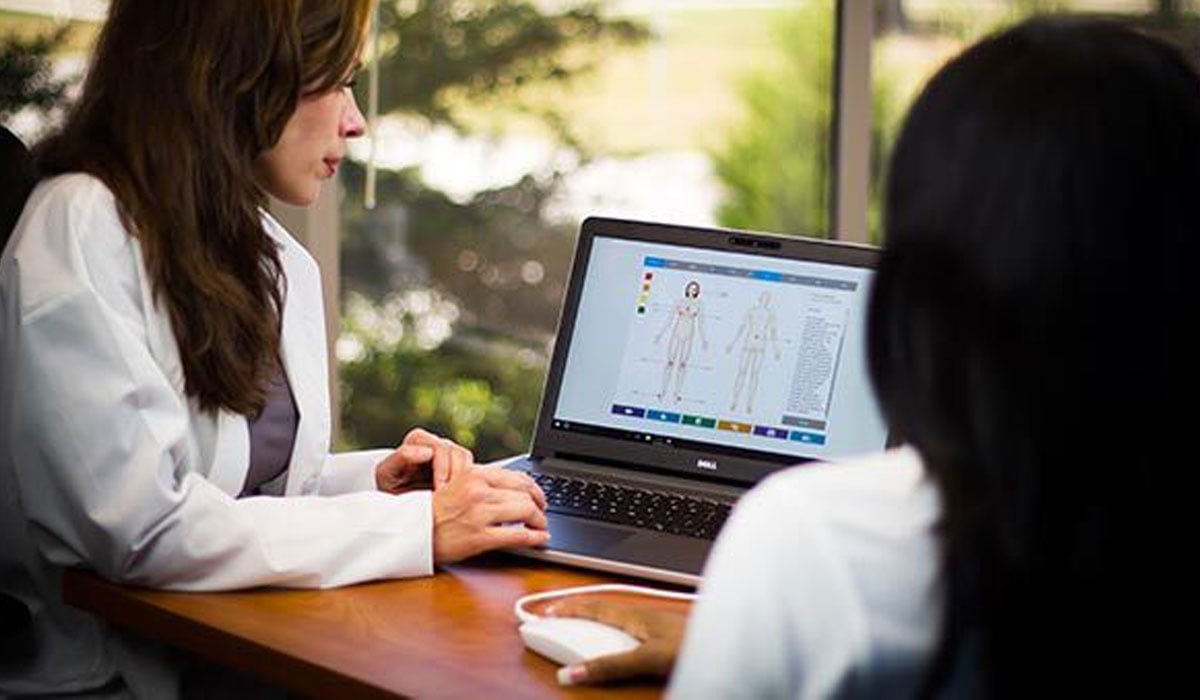When it comes to health, nutrition and pharmaceutical medicine both have their roles. The former provides the physical building blocks needed for good health while the latter may help to mitigate symptoms of disease.
Both, however, approach health from a chemical point of view. The future of health looks beyond that, into the physics of the body. The energy studied in physics is what actually drives the body’s chemistry, so if we can understand energy and how it is controlled, we can support health from a more fundamental level.
We like to call that “getting to root causes,” and this is the role of bioenergetics. There is a conventional area of study where bioenergetics focuses on how cells produce energy (ATP) chemically, but in the bigger sense, bioenergetics looks at all the ways in which energy is accumulated and controlled. And it works on assessing and correcting the body from this level.

So a bioenergetic assessment is something that does not test the body chemically, but tests its energy system to understand it at this deeper level. That said, there are several types of bioenergetic assessments, and we’ve done our best to categorize them here for you so you have a better sense of what’s available.
But first, a couple thoughts on what to look for and what to avoid in a test like this.
What to Look for in a Bioenergetic Assessment
While most bioenergetic assessments focus on testing the health or balance of body parts, in our view, this focus still has us looking at the physical parts of the body rather than its energetic functions. We feel bioenergetics should break this down a little further into 3 primary areas, as these determine whether the energy system is able to correctly guide the body’s operations:
- Energy levels
- Informational integrity / accuracy
- The free flow of that information
This is why, among other things (such as one’s critical alignment with Earth’s own fields), NES Health addresses all of these.
- Energetic Drivers support energy levels in the body-field.
- Energetic Integrators (everyday operations) and Energetic Terrains (the body’s healing or correction system) deal with informational integrity.
- Toxins, pathogens, and perhaps most often, unresolved shocks, traumas, and stress can block the proper flow of information. Many of our Infoceuticals support the body’s process of eliminating toxins. Energetic Terrains are involved with the integrity of the body’s tissues, which can eliminate physical pathogens or their energy signatures. Our Mind-Body Infoceuticals are designed to support the clearing of emotional blocks.
This bioenergetic view of the body is why NES Health doesn’t just test the “liver.” Rather, we test the “Liver Driver” (how well powered is the liver field to power the operations of the liver?); we test the “Liver Integrator” (how well is the liver communicating within itself and with other parts of the body?); and we test Energetic Terrains related to the liver (how well are its corrective messages operating?).
Nutrition (and other elements of lifestyle) are critical partners to all of this, so we don’t discount these at all. In fact, our bioenergetic lifestyle course (available through our practitioners) teaches people all about healthy lifestyle habits across the areas of body, mind, social, and environment. So these are valuable tests within a bioenergetic assessment – most systems, including ours, do look at these. However, we believe that they don’t stand alone – that the information / energy side of wellness needs to play a role for many people in the process of getting well.
Of course we’re not saying that another system will use our terminology – our Drivers, Integrators, and Terrains are naming conventions we developed over decades of mapping out the body’s energy control system. So others won’t use our terms, but you can see why we feel they should be central to an energy assessment.
What to Avoid in a Bioenergetic Assessment
In spite of the obvious legal implications, there are companies whose assessments seem to indicate the physical presence of pathogens or even specific medical diseases. We recommend avoiding assessments like this because they are attempting to make claims about the physical body rather than its energy system. We feel this isn’t an honest representation of what the reading is all about.
In a similar way, we would avoid those that present their assessments as implying the physical presence of toxins or nutritional deficiencies.
NES Health assesses what we call Energetic Terrains, which are the body’s information pathways for keeping tissues healthy (or healing them in response to disease). Because of their association with certain tissues, they may have a secondary relationship to certain pathogens (either physical or virtual), but a priority reading does not claim the presence of a pathogen. We also do not test for any diseases.
We offer an Environmental screen (dealing with toxins) and Nutritional screen, but in both cases we are only assessing the body-field’s response to an item, which could indicate a physical presence or lack of something, but does not necessarily mean that. Our training helps our practitioners understand how to view these readings, and how to appropriately share them with clients.
Types of Bioenergetic Assessments
So now let’s look at the types of bioenergetic assessments available. As we said, they tend to fall into one of just a few categories. We’ve done our best to summarize the types you may run across. Note that we are not mentioning brands, as we don’t want to incorrectly define how someone else’s technology operates nor imply anything negative about a brand. We’re obviously partial to how we do things at NES Health, but we’re also fans of any system that helps people see positive results on their path to wellness.
EDS (Electrodermal Screening)
This is frequently known as EAV (Electro Acupuncture according to Vole), and there are other forms of electroacupuncture as well. These would all fall under the general umbrella of electrodermal screening. This type of assessment uses a point probe to assess the energetic integrity at specific meridian points. This is a time-honored technique in the bioenergetic community, but there are certain drawbacks to this technology:
- The quality of assessment depends on the experience of the practitioner, and practitioner bias can play an especially strong role here.
- Assessments can take a while, as dozens of points are tested, often on both hands and feet (which also may be an uncomfortable type of assessment for some people). This can even be a little painful especially for children, as the metal point is used with some pressure along fingers and toes.
- The assessment is strictly assessing meridian points, while NES Health suggests that there are other aspects of the energy system to consider.
GSR (Galvanic Skin Response)
This type of assessment runs a weak electric signal through the skin, e.g., from the fingers to the palm, and measures the difference from one point to the next. Any substantial changes are measured as stress responses to the data point (test item) being introduced by the computer. The strongest responses are those you would seek to balance with appropriate remedies. An assessment can take 30 seconds to many minutes, depending on the number of test items being checked.
This technology eliminates many of the obvious challenges of EDS, but we have found one major drawback: the ability to manipulate test results at will. We have tested one of the most popular devices and found that moving the fingers slightly during the test registers as a strong stress response for the items being tested at the time of the movement. So it’s not in fact a stress response, but movement of the subject.
This problem was repeatable in our tests. So it’s hard for us to say if all stress responses are based on subtle movements of the client, or if there are legitimate stress responses mixed in with these false positives. In any case, with a test running up to several minutes, one can imagine how often such test results would be thrown off.
We cannot say that this applies to all brands, but are cautious about GSR for this reason.
Bioresonance
This is theoretically similar to what NES Health’s assessment does, but it is different in several important ways.
The idea here is that every aspect of the body has its own healthy frequency. By placing electrodes on the body, you can introduce those frequencies into the body and get a response back and measure whether there is resonance between them. Anything lacking resonance indicates something that isn’t functioning correctly, since obviously whatever is being tested should be in resonance with its representative frequency, so long as it’s healthy.
Again, this is a similar notion to what NES does, so of course we like the goal. But we also observe a few challenges. First, it is electrical once again. We have not tested for this, but suspect that movement once again will alter results (as with GSR). Second, there is the question of whether exact placement of the electrodes makes a difference in the reading.
Third, since this approach deals with simple frequencies, it’s unclear how the body’s response is only coming from the part of the body being tested. If everything in the body is emitting a frequency – and some have claimed 120,000+ frequencies in the body – is it possible that something with the wrong frequency has begun to resonate with the test item? Let us give a concrete example with fictitious numbers for simplicity:
If a liver cell is supposed to have a frequency of 120.1 Hz and a kidney cell is supposed to have a frequency of 120.2 Hz, what happens if the liver has gotten unhealthy and is now at 120.0. Meanwhile, the kidney has gotten unhealthy and is now at 120.1 Hz. When you test the body for 120.1 Hz (to see if there is resonance with the liver), is it possible you’ll get a resonant response from the wrong part of the body (like an unhealthy kidney cell)? That you’ll believe the liver is healthy as a result, when really the liver and kidney are both unhealthy?
Again, that is a simplistic example. But if you’re dealing with simple frequencies, it seems like there’s not enough of a distinction among all the parts of the body. This is why I like the idea of space resonance used by NES Health.
A Word on "Space Resonance"
Let’s briefly discuss the difference between frequencies and space resonance. This gets a little deeper, but I’ll try to keep it as simple as possible. It seems necessary to understand the different assessment types. Then we can look at field-based readings as a final form of bioenergetic assessment.
A fundamental unit of energy, like an electron, will have a pure frequency. Although instead of being a linear frequency like you might see on a graph, it is 3-dimensional – this frequency extends from the particle as a sphere.

Put two particles nearby and their frequency spheres will interact with each other and create “interference patterns,” similar to how ripples in water create new patterns when they interact. The exact nature of these patterns depends on the positions of these two energy particles and their movements.
So what happens when you put a bunch of energy particles together and produce an atom? You have a unique interference pattern showing the relationships of all the energy in that atom. This is far more complex than a frequency, and would never be duplicated by another atom simply “changing frequency.” These patterns represent information in space itself, a kind of energy signature that can only come from that type of atom. Since all atoms of this type, however, have this signature, they are resonant with one another.
In other words, the field of space itself holds information about the forms inside it, and this space has resonance with any other portion of space carrying a similar energy signature. This allows for instant communication at any distance, which we know is a feature of “entanglement” in quantum physics.
What’s more interesting is that, since everything is made of the same energy building blocks, there are elements within every body part that are resonant with one another. This means there is some communication between all parts of the body. But there are more similarities between certain parts than there are between others. So we have a high degree of resonance between specific parts of the body that create strong communication pathways, and these are needed for things to happen correctly in the body. We’ve found that these correlate strongly with the meridians of traditional Chinese medicine – more than just paths of energy, we see them as paths of information transfer, or communication.
This is the basis for real-time coordination of everything happening in the body that exceeds what can be explained by chemistry. For simplicity, we can simply call this “resonance” rather than “space resonance,” but it shouldn’t be confused with the resonance of common frequencies.
After all, as you combine atoms into molecules, and then organelles, and then cells, those energy signatures become ever more complex. You couldn’t possibly measure this against a frequency. But if you can find something that resonates with a healthy tissue, and you can reproduce that in software, then you have a way to test against this more complex “space resonance” nature of the body. (And that is what NES has done.)
Now, similar to bioresonance, you can test for resonance with a complex energy signature; if this is absent, you know what you need to support and bring back into its proper state of resonance. Nothing else, however, could possibly be mistaken for this energy signature because it is such a unique thing compared to anything else in the body.
Field-Based Assessments
This brings us to the last type of bioenergetic assessment. A field-based scanner is one that doesn’t rely on electricity either introduced into the skin or measured from the skin. This means there is no opportunity for a practitioner to alter the reading based on how he or she applies it, and there’s no way for a client or patient to alter the reading through movement during the reading.
Instead, the scan is based on the idea that everything emits a field with its own space resonance, as explained above. This gives us information about the state of any part of the body. This information is emitted outside the body and is carried on sound waves both inside and outside the body. Because of this, we can effectively record this information by interacting either with the skin or the voice. NES Health provides both options.
The quality of a field-based assessment will be based on what you do with that information. NES Health spent decades mapping out the body’s energy control system, which we call the body-field. We mapped out how it’s powered, how communication takes place in it, and how it interacts with its environment. We also determined its preferred flow of information and the order in which to run the necessary tests. And finally, we developed an algorithm by which we check and recheck resonance for accuracy, allowing us to show the degree to which something needs support.
The resonance check itself is also based on these decades of research, where we found mathematical codes that resonated with healthy cells, tissues, and systems. Again, this is similar in concept to bioresonance, except that our resonance isn’t based on frequencies, but these more complex energy signatures based on “space resonance.”
If you're interested to experience a NES Health scan for yourself, our team is glad to demo it to qualified health professionals for free if you reach out to us (888-242-5933). Those who are interested to work with NES Health professionals can find them on our practitioner locator.
Bioenergetic Therapies
Of course following any type of assessment, the most important thing is what you can do about the results. Most bioenergetic tests point you to nutritional supplements, herbs, or homeopathic solutions. There are also bioenergetic therapies that have no assessment process – for instance, a Rife machine introduces electrical frequencies into the body with the goal of killing off pathogens (not our preferred approach), but it doesn’t tell you what pathogens you should be trying to kill off.
A NES Health scan points to the use of the miHealth and Infoceuticals for optimal results. But looking at how these relate to other options, and how they can be used to complement other options or stand alone, is material for another day. We hope, in the meantime, this helps you to understand the types of tests that are commonly available. It’s time we take human health into its next era, working with the body’s energy system, and bioenergetics is the pathway into this future.



.png)
